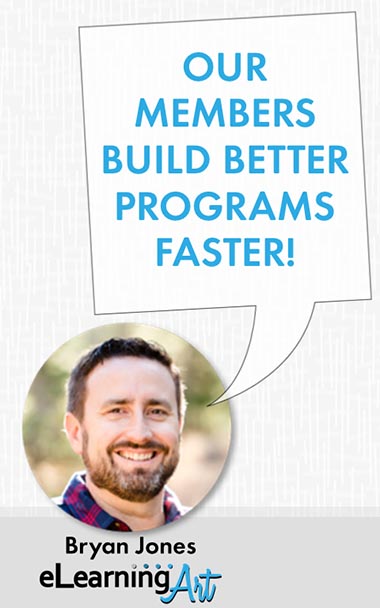Structure and Script Your eLearning Projects
6 practical tips to write better eLearning scripts (template included)
ULTIMATE GUIDE TO ELEARNING DEVELOPMENT
- Plan Your eLearning Projects
- Manage Your eLearning Projects
- Structure & Script eLearning
- Design & Prototype eLearning
- Visualize & Storyboard eLearning
- Develop & Build eLearning
- Publish & Deliver eLearning
Bonus 1: eLearning Development Calculator
Bonus 2: eLearning Best Practices Pro Tips
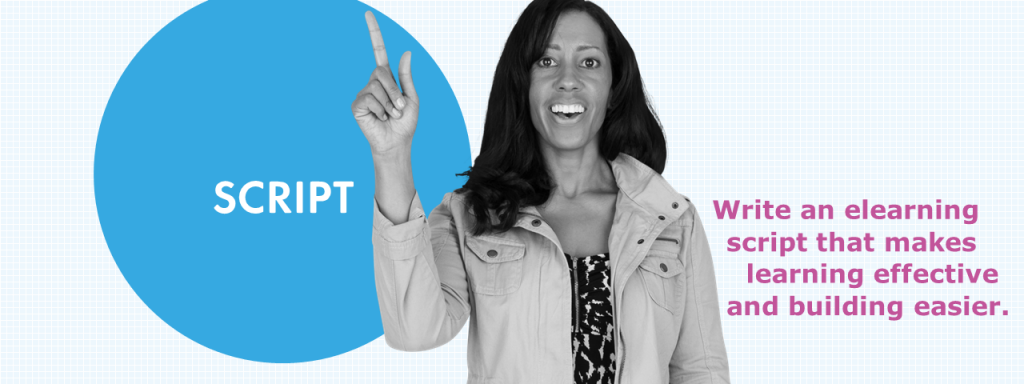
Elearning delivers information, so in spite of its multimedia nature, it is words that drive program development. The document in which these words are organized is typically called a “script.”
An elearning script usually includes some or all of the following:
- A general outline of the program in the form of program title, section titles, and, often slide titles.
- The voice over script in a program with audio voice over.
- On-screen text that coordinates with the voice over script.
- Notes about graphics that coordinate with the voice over.
- Text related to program navigation, user interactions, and other “micro-copy” needed to help the viewer find their way through the program.
- Quiz questions, scenario branching, and other text related to user interactions.
Note that what is included (or not included) in the script is often simply a matter of tradition — there are no strict rules for what should be included in an elearning script. This is good news, because it means you are free to innovate if you feel a different format would be useful!
Set up Your eLearning Script Template
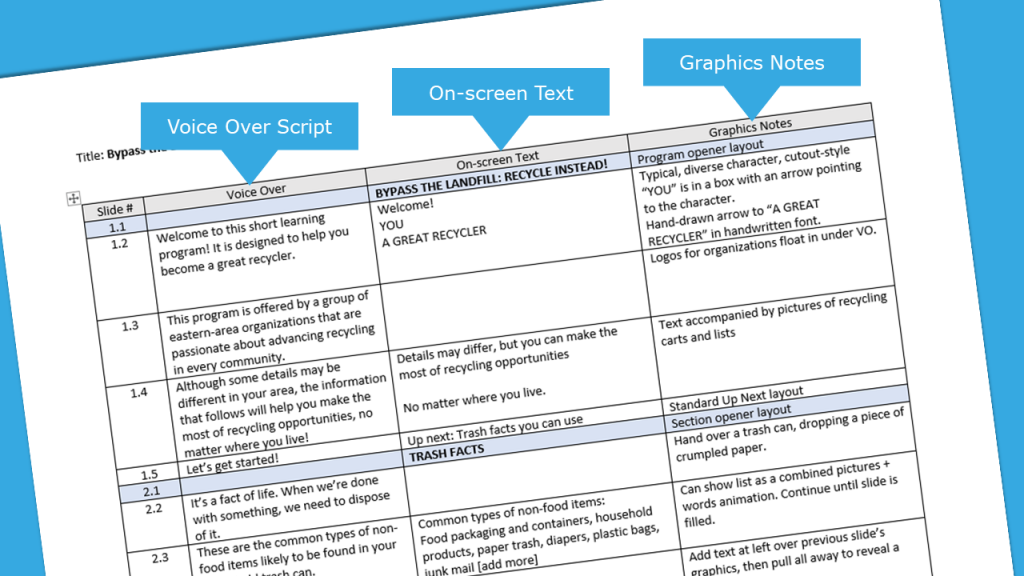
Script Software
Scripts are most often developed in Microsoft Office applications like Word and PowerPoint, but tools like Google Docs, Open Office, and other word processors can also be used.
The only rule for which application to use is that the script should be worked up in a format that’s most comfortable for and useful to those who must interact with it. That might include lots of different people, including your project sponsor(s), subject matter experts, legal and compliance reviewers, teammates, elearning developers, and others. The more people who must review a script, the more it will pay off to make a smart choice about the development tool for your script.
So, for example, if you and one other person are working on the project and that’s it, you might be comfortable creating your script in PowerPoint with its strong graphics and good-enough text handling, but not so great commenting features. On the other hand, if your script is going to be shared with and reviewed by multiple people, you’ll be better off in developing it in Word, where you can turn on Track Changes and ask reviewers to use the comment tools.
Script Samples and Types
If you are mainly focused on the narrative part of the script (i.e., the voice over script or the material to be read by the viewer), then a simple top to bottom format with slide titles called out as headings will allow you to write in a well-paced, flowing way:
If you’re including other details such as on-screen text and graphics notes, you may find that a page set to landscape and using table formatting makes it easier to manage the details. For this format, think of each row in your table as referring to a single slide, and set the columns to include space for the writing you will be doing.
Free eLearning Script Template
Get our free eLearning script template today!
No need to start from scratch. This simple script template in Word will kickstart your script writing process.

Use Tone to Write Better eLearning Scripts
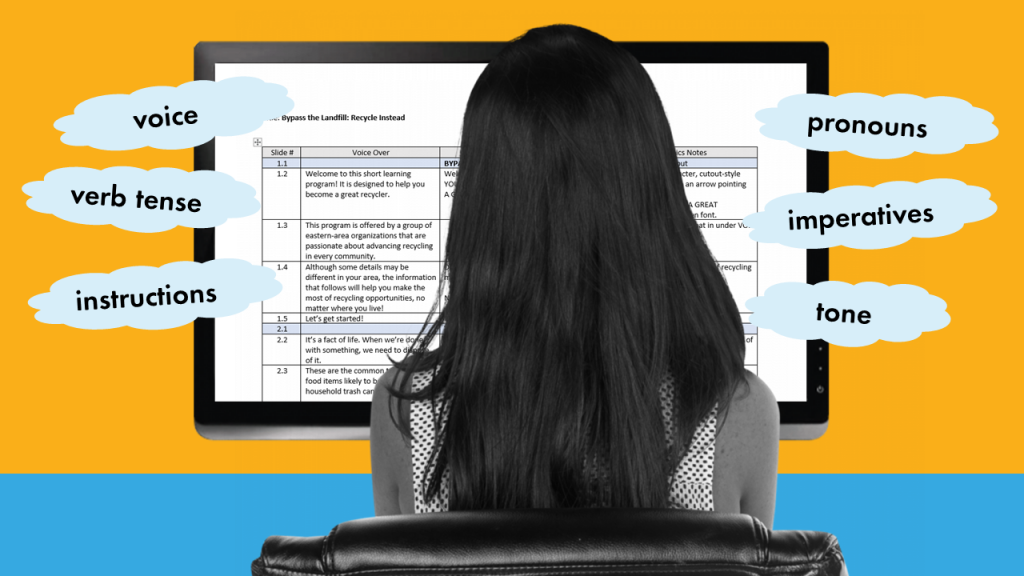
As with all forms of writing, it really pays to think about the people for whom you’re writing and the subject matter you are writing about so that you can choose the right “voice” for the information. The goal in setting the tone is to match both the audience and the subject matter in terms of word choice, sentence structure, point of view, and seriousness. You can probably imagine how your response to each of those would be different if you were creating a program on, say, product safety for an audience of pharmaceutical scientists versus a program on a start-up’s new bring-your-dog-to-work policy.
At both ends of the tone spectrum, you’ll want to build consistency into your writing approach. Here are a few areas to pay attention to:
- Pronouns: If you use the pronoun “we” to refer to the collective people in your company, be careful about switching to “you” arbitrarily. (Good: “At Acme, we value our customers. We serve them attentively.” Not so good: “At Acme, we value our customers. You must serve them attentively.”) Avoid switching back and forth between collective and individual pronouns — it’s confusing and can sound a little accusatory. Instead, choose one or the other and make the most of that choice.
- Verb Tenses: Another point of consistency comes in the form of verb tenses. For your first draft, you may find that free writing helps capture the information you need to present, but you owe your viewers a good review of that writing to make sure that the logic of verb tenses is working in the direction of comprehension.
- Suggestions vs. Rules: Even when the tone of an elearning program is friendly and conversational, it’s important to use clear language signals to help your viewers take away exactly what they need to know. For example, read the sentence, “You should turn the dial clockwise if the LED glows green.” Does that feel optional to you, as though it’s a suggestion? The words “should” and “if” may be signaling that. In contrast, does the following sound more like a rule to you? “You must turn the dial clockwise when the LED glows green.” In elearning, it’s important to vette your word choices so that they will convey the exact meaning and viewer understanding you intend.
- Micro Instructions: When you drive down the highway in the US, you’ll note that all the signage is the same. That’s intentional because when issuing instructions, keeping the same experience from instance to instance means less processing time for the driver. The same is true for our elearning programs. If you need to issue an instruction — a cue to the viewer — no need to be fancy. Just develop a list of well-worded instructions (sometimes referred to as “micro copy” or “micro instructions”) and choose from that list every time. No need to get fancy.
Those are just a few areas in which it pays to build awareness so you can write the best elearning script possible. As you write your scripts, pay attention to things like this that you see. Making a note of them and reviewing your notes before writing a script will help you get better and better at setting the tone and avoiding the problem areas.
Reduce eLearning Development Time with a Good Script Structure and Process
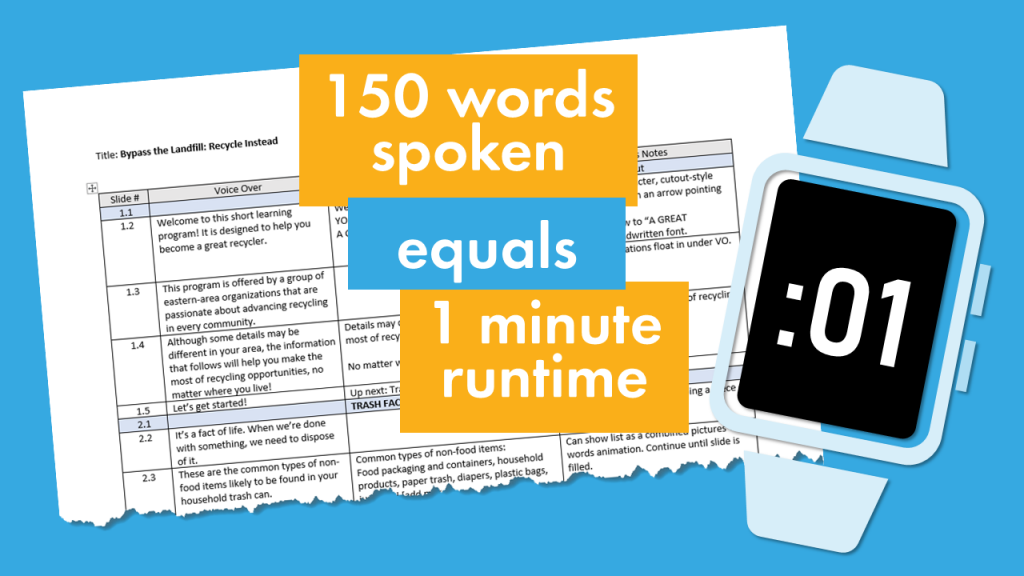
Some subjects (and subject matter experts) can supply a seemingly endless amount of content for your script. Because there is a direct relationship between the length of your script and program development time, you will want to manage the script writing process carefully, before you start building!
In fact, some developers swear by “staying in the script stage” as long as possible. That’s because the better the script, the easier it will be to build a program from it. You may find that this policy helps you, too, so don’t be in a rush with the script because you think that will get you to the fun part of building sooner. Instead, remember that the fun part is much more enjoyable when you’re not making up for a bad script with every slide you build. (Ugh, hard lesson!)
So, what are some strategies for writing with program building in mind?
1: Pay attention to word count
A rule of thumb worth remembering is 150 words spoken = 1 minute of elearning runtime. That means if a particular slide’s voiceover script is 150 words long, the slide will be in front of the viewer (or “run”) for one full minute. In a medium where even single seconds can feel very long, one minute is a lifetime! Long slides are also more difficult to build, because the timeline itself is longer and you’re likely to be managing more text and objects across that timeline. When you go to build, you’ll appreciate it if your script keeps slide word count to around 60 words.
2: Control program length
Using the same 150 words = 1 minute of runtime metric allows you to figure out how long your total program will be. That means if your project sponsor has asked for a 15-minute program, the voice over word count in your script should be no more than 150 words X 15, or 2,250 words. (And note: That’s for everything, including the introduction, conclusion, mandatory navigation and learning objectives, and micro copy, so the word count for the actual “meat” of the program will be less.) By keeping a watch on the word count as you develop the script, you can detect when the count is going too high. That way decisions can be made early about what information may be “nice to have” instead of “need to have.”
3: Use short sentences and simple words
Shorter sentences and simple words serve as important tools. They help comprehension because your viewer can better follow what’s being said. They compel the scriptwriter to think simply about the information being presented, and speed up writing, too. Shorter sentences sound better in voice over, whether it’s a live voice or a text-to-speech voice, and simple words are easier to read and pronounce correctly.
4: Review scripts written by non-elearning people carefully
Your subject matter expert may be a wizard at Word and more than happy to write the script for you. Nice! Say yes to that, but also gently suggest that you reserve the right to edit the script to make it work for the elearning environment. This will allow you to enjoy the best of both worlds, because you’ll have a script that’s both great on content and effective for delivering in a slide-based format.
5: Think about what’s going on on-screen
Many of us learned to write in academic settings where a strong emphasis was placed on a formal form of writing. Wordy constructions, the passive voice, long sentences, heavy use of prepositions, and built-in referencing are what we learned, but these don’t work well in the multimedia environment of an elearning program. When you write with the idea that you’ll be supporting the words with graphics on-screen, you’ll soon realize that you must seek ways to deliver the required information using concrete nouns, active verbs, and short sentences. For example, imagine the difficulty of creating an interesting slide to match this voice over: “According to recent longitudinal studies, there are six key ways in which people reconcile the health information they receive from medical professionals. These include …” Doable, but with dull results and the potential for a few seconds of blank slide space. Now try this one: “People think about information from medical professionals in six key ways. These include …” It’s likely that you’re better able to imagine an attractive slide from the second sentence, and you’ll probably agree that the slide will be more interesting for viewers, too. Those two benefits arise directly from the writing.
6: Consider storytelling strategies
We humans love stories and are wired to take away insight and learning from every story we hear. Why not take advantage of this human tendency and write a script that delivers key content via scenarios, short simulations, and other storytelling approaches? Stories need a setting, character(s), and a plot arc, and you’ll be surprised at how easy it is to craft these from the most snooze-y of instructional material. Building the slides to deliver the stories is easy, too — use photo or illustrated people to represent the story characters and you’ll have the job done in no time! One caveat is important, though: You will want to get your project sponsor and subject matter experts fully on-board with the storytelling idea before you go too deeply into scriptwriting. They may think that presenting the information in the usual top-to-bottom format is the only effective way to get the content across, so be ready to sell them a little on the idea. The prototype, described in the next section, is a spot where you can show them what you have in mind.
In Conclusion
Those are a few script writing tips and tools that you can make use of to smooth the building process. As you build programs, make a note of what works (and doesn’t). Soon you’ll be an ace scriptwriter and look forward to this stage of your elearning project!
eLearning Script FAQs
Scriptwriting is an important step in elearning development. A script blends content and instructional design to create a foundation for program design and development. Try to write clearly using simple words and short sentences. These will be easier to support with on-screen visuals and easier to understand if your program has live or text-to-speech voice over. Put the action of each sentence and slide first. For example, if you cite a study, write: “Nine out of 10 people love elearning, a study from the Institute for Better Learning Outcomes says,” not “A study from the Institute for Better Learning Outcomes says 9 out of 10 people love elearning.” The first version lets you illustrate the key of the sentence right away, but the second leads to blank slide space where nothing happens.
Text-to-speech (or “TTS”) applications deliver computer-generated voice over that is great for use in the draft stages of your elearning project. One challenge with TTS is pronunciation. The “voice” reads and records very literally and may get pronunciations wrong. To ensure the best-possible output, spell the words the voice stumbles on phonetically, even if it looks funny to your human eyes. If you want an acronym to be pronounced as separate letters, try adding spaces between each of the letters. Watch out for odd contractions, extraneous punctuation, and other little gremlins that the TTS generator will “see” and read aloud. At first, you may feel that TTS sounds pretty awful, but in our experience, it’s a great stand-in for the more expensive and less convenient live voice over. Some people use it for final programs, and today’s TTS is sounding better and better, so give it a try. You may like it!
By the time you’re recording your own live voice over or sending a script to a pro voice over artist, you want to feel that your script is truly done. Why? Because each change that’s required after the first round of recording is more inconvenient and less likely to sound like it fits with the rest of the voice over audio. Instead of trying to perfect a script and procuring live voice over in advance of building your elearning, it’s better to use TTS throughout the build as “scratch audio” so you can continue to polish your script. Small statements such as “Click Next to continue.” are easy to overlook in the original script writing phase, with their necessity becoming obvious during the building process. Do yourself a favor and avoid pricey “pick ups” to fix issues by ordering live voice over only after the program has been finalized.
The addition of audio in your elearning program enhances the multimedia experience. In general, you want an auditory experience to feel smooth, easy, and pleasant for the viewer. That means avoiding loud or startling sounds and volume changes, deleting things like coughing, throat-clearing, and mouth clicks in voice over files, and planning music and other sounds that match the overall feel of the program. You can use sound effects to emphasize right and wrong answers or results, to help illustrate a visual, or to otherwise add interest to your program. Remember that you want your audience to listen to the program, not to tune it out because the audio is bothersome, so make sure to address any audio-related comments you may receive from reviewers or program participants.

